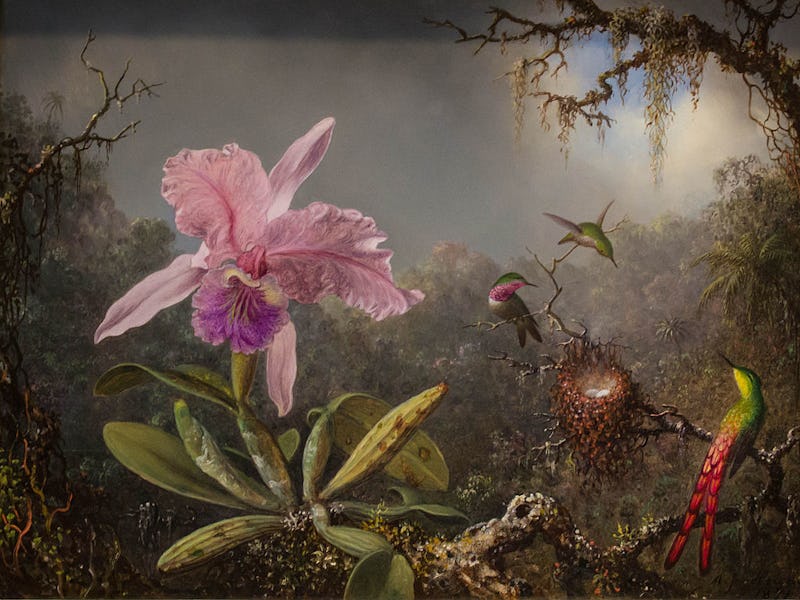Scientific Breakthroughs That Changed Art Forever
Who says art and science can't get along?

Though we often think of art and science as completely separate — thanks largely to academic tracks and mass-media stereotypes — that tired description, “it’s an art and a science,” is tired for a reason. Art is an art and a science. Science is an art and a science. The one has never existed without the other.
Here are the science breakthroughs that changed the course of art forever.
Pigments
The works most often cited as the oldest on Earth are the 20,000-year-old cave paintings at Lascaux, France. Made using the crushed iron oxide deposits and other minerals, the earliest pigments known, the paintings are still remarkably colorful. Unlike dyes, usually derived from plant and animal materials, these pigments were relatively permanent and could withstand changes in the environment.
As artists and scientists experimented with different minerals and binders (and they got creative, using materials such as urine, animal fat, and blood), they developed pigments such as mummy brown, made literally from crushed-up mummies, and the lapis lazuli-derived ultramarine, which had such a prohibitively high price that it put countless artists in debt. Perhaps the most important — and the most deadly — was a pigment known as White Lead, which gave many Renaissance paintings their characteristic luminosity and, thanks to its chemical makeup, gave many artists a serious case of lead poisoning.
The Telescope
Before Galileo showed us how to observe the cosmos, the sun, moon, and stars belonged firmly to the realm of the gods. Paintings made before the invention of the telescope showed the heavens as a magical realm; the sun and moon in Raphael’s “Mond Crucifixion” literally have faces, gazing out at the viewer. The invention of the telescope revealed these celestial objects as physical, observable bodies. Taking this to heart, artists began to follow a more realistic approach; Donato Creti’s painting “Moon and Jupiter” shows stars and planets as viewed through a telescope, and, carrying the tradition further, Van Gogh later captured the subtle flickering of the stars in his famous “The Starry Night”.
Plaster
The discovery of plaster, essentially a mixture of heat-treated, powdered gypsum, limestone, or cement with water, led to the development of some of the oldest known architectural and artistic techniques. Plaster was used to smooth walls, floors, and ceilings as early as 9,000 BC in Mesopotamia (and was conveniently also flame retardant), and it was used for decorative purposes in buildings throughout the Roman empire.
Later, the famous frescoes of the Sistine Chapel and Da Vinci’s “The Last Supper” were painted on freshly laid plaster, giving them their characteristic richness of color and depth. Plaster casting was later used to produce replicas of original sculptures, allowing museums and arts academies to fill in gaps in their collections of antiques relatively inexpensively, allowing greater access to the public and paving the way for a more democratic approach to art.
Photography
In 1839, Louis-Jacques-Mandé Daguerre, a Romantic painter and printmaker, announced his discovery of ‘daguerrotypy’, the first-ever photographic process. This new medium used light and chemistry to ‘print’ an image directly onto a treated sheet of silver-plated copper. The new technique was met with both praise and criticism: On one hand, photography allowed artists to immediately replicate what they were viewing, solving one of art’s earliest dilemmas; on the other, its mechanized nature raised questions about its place in the world of art. Despite its critics, early photography had a serious impact on art, especially on Realists such as Gustave Courbet, whose work is characterized by his painstaking attention to replicating detail.
Even before the daguerrotype, there existed the camera obscura, which projected live images (upside-down, but with color and perspective intact) onto a piece of paper, which, when traced, resulted in highly accurate replications of the original scene. It’s rumored that Vermeer, whose paintings are widely praised for their photographic quality, ‘cheated’ with the help of this technique.
The Theory of Evolution
Darwin’s revolutionary theory, published first in “On the Origin of Species” in 1859, had a profound impact on all aspects of society, not least on religion and art, which at the time were very closely linked. Knocking mankind down from its place just below God, the theory of evolution posited that we were products of an elaborate system.
Artists began to bring these ideas into their work, depicting animals with human characteristics, as in “The Sick Monkey” (1875) by William Henry Simmons, and humans with animal characteristics (Darwin wrote extensively on shared facial expressions), as in Degas’ “Head of a Criminal, Émile Abadie” (1881). Other artists focused on Darwin’s fascination with sexual behavior and courtship patterns in the natural world, as seen in paintings such as the voluptuous “Cattleya Orchid and Three Hummingbirds” (1871) by Martin Johnson Heade.